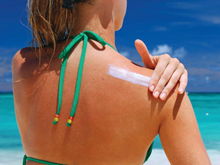Health Topics
-
Healthy Living
-
|
|
September 2010
|
| Screening out the Sun |
| Dr. Sumit Kumar Bose |
| |
 |
Even in these non-summer months, the sunlight is more intense and harmful than in the years past - due to depletion of the ozone layer. Here’s what you should know. |
Protection from light, or photoprotection, is the leading preventive health strategy used by physicians involved in skin care. Sun avoidance is most desirable, however, outdoor occupations and lifestyles make total avoidance impossible. Adding to this, is the misconception that in the non-summer months, it is pretty OK to be out in the Sun – particularly because you don’t feel the heat burning down on your skin. But since we are assured that the Sun is always out there with its radiations – even on cloudy days - the regular use of sunscreens represents a practical compromise. Sunscreens prevent the formation of Sun related keratosis (a skin condition marked by an overgrowth of layers of horny skin), Sun related elastosis (breakdown of elastic†tissue), pigmentation of face, wrinkles, sagging skin and loss of glow and lustre and skin cancer.
Drug photosensitisation and photo-induced or photo-aggravated dermatoses (disorder involving lesions or eruptions of the skin) may be prevented with sunscreen use, especially with products that offer better blockage in the UV-A range.
SPF
Ultra Violet Radiation (UVR) that reaches the Earth's surface can be divided into UV-B (290-320 nm) and UV-A (320-400 nm). UV-A can be further subdivided into UV-A I, or far UV-A (340-400 nm), and UV-A II, or near UV-A (320-340 nm).
Sun Protection Factor (SPF) is defined as the dose of UVR required to produce one Minimal Erythema Dose (MED) on protected skin after the application of two mg/cm2 of product, divided by the UVR required to produce one MED on unprotected skin. Erythmea, by the way, is the abnormal redness of the skin as in sunburn or inflammation, resulting from dilation of blood†vessels.
A water-resistant product maintains the SPF level after 40 minutes of water immersion, whereas a very water-resistant (formerly waterproof) product maintains the SPF level after 80 minutes of water immersion. A broad-spectrum or full-spectrum sunscreen provides both UV-B and UV-A protection, ideally through the entire UV-A I and UV-A II range.
Arguably, an SPF 15 sunscreen provides full UV-B protection for healthy individuals. It filters out more than 93 percent of UV-B radiation, while an SPF 30 product filters out around 97 percent, and less. UV-A protection is better with a higher SPF, particularly in the UV-A II (320-340 nm) or shorter UV-A range.
Blockers
Sunscreens have traditionally been divided into chemical absorbers and physical blockers on the basis of their mechanism of action. Chemical sunscreens are generally aromatic compounds conjugated with a carbonyl group – if you remember a bit of your Class XII Chemistry lessons.
Physical blockers, sometimes referred to as nonchemical sunscreens, reflect or scatter UVR. Newer microsized forms of physical blockers may also function in part by absorption. Some of the original sunblocks were opaque formulations like titanium dioxide and zinc oxide, reflecting or scattering UVR. Poor cosmetic acceptance had limited the widespread use of these ingredients until†microsized forms,†also known as inorganic particulate sunscreens became available.
UV-A Protection
Although sunscreens provide excellent UV-B protection, they lack in UV-A protection, particularly UV-A I. With the availability of higher SPF products allowing individuals to spend greater amounts of time in the Sun without burning, concerns have been raised about the adequacy of the UV-A protection of these products. In fact, individuals relying on sunscreens as their sole form of photoprotection may now be subject to greater cumulative Sun exposure, including UV-A radiation!
Vitamin D Deficiency
Watch out if you are a regular sunscreen user though - it can diminish UV-dependent synthesis of vitamin D by your skin. Elderly persons are particularly susceptible to the consequences of vitamin D deficiency, including osteopenia (having low bone density, but not low enough to be considered as osteoporosis) and bone fractures.
But don’t worry - clinical trials have shown that individuals instructed in carefully applying sunscreens are able to receive enough sunlight to maintain normal vitamin D levels. While it remains that optimal vitamin D levels have not yet been defined, ample vitamin D levels can be obtained from incidental Sun exposure, diet and supplements. Supplements containing up to 1000 IU of vitamin D, particularly in older individuals, could be helpful.
|
| Dr. Sumit Kumar Bose is Sr. Consultant Dermatology at Apollo Indraprastha Hospitals, New Delhi |
|
|